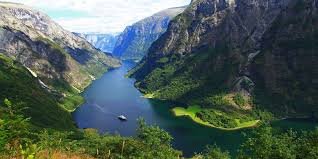Formation of Fjords:
Fjords are long, deep, narrow bodies of water that reach far inland, typically flanked by steep cliffs or mountains. They are formed through a series of geological and glacial processes:
- Glacial Carving:
- Glacial Movement: Fjords are primarily formed by the action of glaciers. During ice ages, large glaciers form and move down from highlands towards the sea. These glaciers carve out deep U-shaped valleys through a combination of plucking and abrasion, where rocks and sediment are picked up and ground against the bedrock, deepening and widening the valley.
- Over deepening: The glacier’s weight and movement exert immense pressure, leading to over deepening of the valley, often below sea level.
- Melting and Sea Inundation:
- Glacial Retreat: As the climate warms, glaciers begin to retreat. The valleys carved out by the glaciers are often below sea level.
- Sea Inundation: When the glaciers retreat, seawater floods the over deepened valleys, forming fjords. This process creates the steep, dramatic cliffs that are characteristic of fjords.
- Post-Glacial Adjustment:
- Isostatic Rebound: After the glaciers melt, the land that was previously compressed by the weight of the ice begins to slowly rise, a process known as isostatic rebound. This can further shape the fjord’s structure and sometimes cause shallow areas or sills near the fjord’s mouth.
Picturesque Nature of Fjords:
Fjords are considered some of the most picturesque areas in the world for several reasons:
- Dramatic Landscapes:
- Steep Cliffs and Mountains: The steep cliffs rising directly from the water create a dramatic and awe-inspiring landscape. The sheer scale of these natural formations is visually striking.
- Deep Blue Waters: The deep, often clear waters of fjords add to their beauty, reflecting the surrounding landscapes and skies, creating stunning vistas.
- Glacial Features:
- Glacial Remnants: Many fjords have visible remnants of their glacial past, such as hanging valleys, waterfalls, and striations on the rocks, adding geological interest and visual appeal.
- Vegetation and Wildlife:
- Lush Vegetation: The cliffs and surrounding areas of fjords often support unique and lush vegetation, including forests and alpine plants, contributing to their scenic beauty.
- Wildlife: Fjords are home to diverse wildlife, both terrestrial and marine, including seals, whales, and various bird species, enhancing the natural allure.
- Waterfalls:
- Cascading Waterfalls: Many fjords feature spectacular waterfalls that cascade down the cliffs, particularly in areas with significant rainfall or glacial melt, creating dynamic and picturesque scenes.
- Seasonal Changes:
- Changing Scenery: Fjords offer breathtaking views that change with the seasons. Snow-covered peaks in winter, blooming vegetation in spring and summer, and vibrant foliage in autumn create diverse and ever-changing landscapes.
Examples of Picturesque Fjords:
- Norwegian Fjords: Known for their grandeur and beauty, the Norwegian fjords, such as Geirangerfjord and Nærøyfjord, are among the most famous and picturesque in the world.
- New Zealand’s Fiordland: Fiordland National Park in New Zealand, home to fjords like Milford Sound and Doubtful Sound, offers dramatic scenery and rich biodiversity.
- Chilean Fjords: The fjords in southern Chile, including those in the Patagonian region, are renowned for their remote and wild beauty, with towering mountains and glaciers.
Conclusion:
Fjords are formed through the powerful geological processes of glacial carving and sea inundation, creating deep, narrow, and dramatic landscapes. Their picturesque nature is due to the combination of steep cliffs, deep blue waters, lush vegetation, abundant wildlife, and dynamic seasonal changes. These features make fjords some of the most visually stunning and captivating natural formations in the world.


